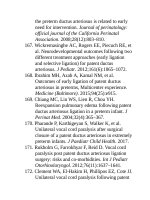Andersons pediatric cardiology 1859
Bạn đang xem bản rút gọn của tài liệu. Xem và tải ngay bản đầy đủ của tài liệu tại đây (125.15 KB, 3 trang )
andthepulmonaryarteries(A).Thisiscombinedwithpatchaugmentation
ofthepulmonaryarteries(B).Finally,apatchiscreatedtoseparatethe
anastomosisbetweenthesuperiorcavalveinandthepulmonaryartery
fromtheatrium(C).(FromJonasRA.Theintra/extracardiacconduit.Semin
ThoracCardiovascSurgPediatrCardSurgAnnu.2011;14:11–18.)
Forpatientswithnonstandardanatomy,theSCPCcanbemorechallenging.
Forthepatientwithbilateralsuperiorcavalveins,thedecreasedcaliberofthe
individualcavalveinsmakescreatinganonstenoticconnectionmore
challenging.Onepotentialadvantageistheabilitytoperformtheindividual
anastomosessequentially,restoringdrainagetotheipsilateralpulmonaryartery
beforeinitiatingthesecondanastomosis.Asaconsequencetheprocedurecanbe
donesafelywithoutindividualcannulationofthesmallerbilateralsuperiorcaval
veinsand,inselectedcases,canevenbedonewithoutcardiopulmonarybypass.
Nonetheless,thepresenceofbilateralsuperiorcavalveinsincreasestheriskof
thromboticcomplicationsandgrowthofthecentralpulmonaryarteries.Bilateral
superiorcavalveinsincreasestheriskofboththesecond-stageoperationandthe
riskofthesubsequentFontanprocedure.217,218Successfulstrategiesinclude
creatingtheanastomosesbetweentheindividualsuperiorcavalveinsascentrally
aspossibleandmanagingcentralpulmonaryarteryhypoplasiaatthetimeofthe
completionFontan.219
Especiallyamongpatientswithleftatrialisomerism,theinfrahepaticvena
cavamaybe“interrupted,”returningthesuperiorcavalveinviaanazygos
vein.220Interruptedinferiorcavalveinwithazygoscontinuitytoasuperiorvena
cavacanoccurwithasinglerightorsingleleftcavalveinorbilateralsuperior
cavalveins.Inthissituationabidirectionalsuperiorcavopulmonary
anastomosis,alsoknownasaKawashimaprocedure,includesallofthesystemic
venousreturnwiththeexceptionofthehepaticvenousreturn.221The
Kawashimaprocedureperformedinearlyinfancycarriesahigherfailurerateas
theimmaturepulmonaryvascularbedisunabletoaccommodatetheincreased
bloodflow.222,223AsaconsequencetheSCPCisoftendelayedinpatientswith
interruptedinferiorcavalveinsandazygoscontinuation.Bilateralsuperiorcaval
veinsoccurcommonlyamongpatientswithinterruptedinferiorcavalveins,and
thisfurtherincreasestheriskassociatedwithsecond-stagepalliation.
DecisionMaking:WhenIsItSafetoLeavethe
OperatingRoom?
TheidealcandidateforfUVHpalliationshouldhavegoodsystolicanddiastolic
ventricularfunction,acompetentorrepairableAVvalve,confluentnonstenotic
orrepairablebranchpulmonaryarteries,andsinusorpacedAVrhythm.The
SCPCisgenerallyawell-toleratedprocedurethatrelievesvolumeworkand
improveshypoxemia,albeitattheexpenseofanelevationofcentralvenous
pressure.Thetwomostcommonadverseoutcomesareexcessivehypoxemiaor
anunacceptabledegreeofcentralvenouspressureelevation.Thesecond-stage
operationisbeingdoneatayoungerage(~4months)andevenearlier
progressiontostage2isusedasstrategytogetpatientsoutofthevulnerable
interstageperiod.224Asaconsequencetheymaynotbeidealcandidatesandmay
havemildlyelevatedPVRs.225Priortoweaningfrombypass,recruitmentand
suctioningofairwaysecretionsshouldbeperformed.Thelungsshouldhave
goodcompliancewithoutexcessiveairwaypressureandthereshouldbenoareas
ofatelectasis.Thetypicalupperbodyvenouspressurefollowingan
uncomplicatedsuperiorcavopulmonaryanastomosisis17mmHg,andthe
transpulmonarygradientmaybeslightlyelevatedat8mmHg.226Arterial
saturationsarecommonlyinthehigh70s.Ingeneralthesevaluesintheyoung
SCPCpatientwillimproveinthefirstdayortwofollowingsurgery.
Unacceptablehypoxemia,anarterialsaturationlessthan75%,shouldprompt
investigation.Ifthecentralvenouspressureiselevated,thelikelycauseis
obstructiontopulmonarybloodflow.Thecavopulmonaryanastomosisand
branchpulmonaryarteriesshouldbecarefullyinspected.Obstructionto
pulmonaryvenousdrainagesuchasarestrictiveatrialseptaldefectwithmitral
atresiashouldberuledout.Excessivehypoxemiainthefaceofanormalorlow
centralvenouspressureshouldraisethepossibilityofavenovenouscollateral
suchasapatentazygosveinorleftsuperiorvenacavathatallowsforshunting
ofbloodfromthesuperiorvenouscompartmenttothecommonatriumorbelow
thediaphragm.Incasesofelevatedcentralvenouspressurewithoutexcessive
hypoxemia,themostlikelyculpritisanaccessorysourceofpulmonaryblood
flowsuchasapatentshunt,pulmonaryartery,orsignificantaortopulmonary
collateral.227Finally,excellenthemostasiswillavoidongoingtransfusion,which
canadverselyaffectlungfunction.
PostoperativeConsiderationsFollowingthe
SuperiorCavopulmonaryConnection
ThemostrecentreportoftheSocietyofThoracicSurgeonsCongenitalHeart
SurgeryDatabaseshowsthatoverthelast4yearstheaveragemortality
followingtheSCPCwas2%andthemedianlengthofstaywas14days.228In
theSingleVentricleReconstructionTrial,factorsassociatedwithprolonged
lengthofstayincludedcenter,longerpost-Norwoodlengthofstay,nonelective
timingofSCPC,andpulmonaryarterystenosis.Mortalitywas4%andwas
associatedwithnonelectivetimingofSCPC,moderateAVvalveregurgitation,
andAVvalverepair.201,225,229,230Specificpostoperativeconsiderations
followingtheSCPCareincludedinBox71.6.
Box71.6
PostoperativeConsiderationsFollowingthe
SuperiorCavopulmonaryConnection
■Bedsidepreparednessandinvasivemonitoring
■Bleeding
■Effectsofpositive-pressureventilationandearlyextubation
■Hypertension
■Pain/irritability
■Rhythmdisturbances
■Effusions(chylothorax)
■Familysupportanddischargeplanning
■InterstageIIsurveillanceandmonitoring
BedsidePreparedness
Theprinciplesofbedsidepreparednessdiscussedearlierfollowingneonatal
palliationareidenticalfollowingaSCPC—specificallyenvironmentalandstaff
preparedness(seeBox71.3).Theseincludecommunicationwiththeoperating
roomandanesthesiateamregardingtheintraoperativecourse,bleeding,
vasoactiveagents,andechocardiographicfindings.Specificallyfollowingthe
SCPC,therearephysiologicbenefitsofearlyextubation,andtheseshouldbe
discussedbetweentheteamintheoperatingroomandteamintheintensivecare









